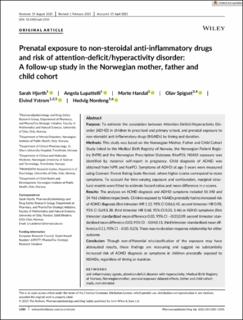| dc.contributor.author | Andersen, Sarah Hjorth | |
| dc.contributor.author | Lupattelli, Angela | |
| dc.contributor.author | Handal, Marte | |
| dc.contributor.author | Spigset, Olav | |
| dc.contributor.author | Ystrøm, Eivind | |
| dc.contributor.author | Nordeng, Hedvig Marie Egeland | |
| dc.date.accessioned | 2021-10-11T10:53:04Z | |
| dc.date.available | 2021-10-11T10:53:04Z | |
| dc.date.created | 2021-10-01T01:16:06Z | |
| dc.date.issued | 2021 | |
| dc.identifier.citation | Pharmacoepidemiology and Drug Safety. 2021, 30 (10), 1380-1390. | en_US |
| dc.identifier.issn | 1053-8569 | |
| dc.identifier.uri | https://hdl.handle.net/11250/2789002 | |
| dc.description.abstract | Purpose
To estimate the association between Attention-Deficit/Hyperactivity Disorder (ADHD) in children in preschool and primary school, and prenatal exposure to non-steroidal anti-inflammatory drugs (NSAIDs) by timing and duration.
Methods
This study was based on the Norwegian Mother, Father and Child Cohort Study linked to the Medical Birth Registry of Norway, the Norwegian Patient Registry (NPR) and the Norwegian Prescription Database (NorPD). NSAID exposure was identified by maternal self-report in pregnancy. Child diagnosis of ADHD was obtained from NPR and NorPD. Symptoms of ADHD at age 5 years were measured using Conners' Parent Rating Scale-Revised, where higher scores correspond to more symptoms. To account for time-varying exposure and confounders, marginal structural models were fitted to estimate hazard ratios and mean difference in z-scores.
Results
The analyses on ADHD diagnosis and ADHD symptoms included 56 340 and 34 961 children respectively. Children exposed to NSAIDs prenatally had no increased risk of ADHD diagnosis (first trimester: HR 1.12, 95% CI 0.86;1.45, second trimester: HR 0.98, 95% CI 0.69;1.38, third trimester: HR 0.68, 95% CI 0.31; 1.46) or ADHD symptoms (first trimester: standardized mean difference 0.03, 95% CI −0.03;0.09, second trimester: standardized mean difference 0.03, 95% CI −0.04;0.11, third trimester: standardized mean difference 0.11, 95% CI −0.03; 0.25). There was no duration-response relationship for either outcome.
Conclusion
Though non-differential misclassification of the exposure may have attenuated results, these findings are reassuring and suggest no substantially increased risk of ADHD diagnosis or symptoms in children prenatally exposed to NSAIDs, regardless of timing or duration. | en_US |
| dc.language.iso | eng | en_US |
| dc.publisher | Wiley | en_US |
| dc.rights | Navngivelse 4.0 Internasjonal | * |
| dc.rights.uri | http://creativecommons.org/licenses/by/4.0/deed.no | * |
| dc.title | Prenatal Exposure to Non-Steroidal Anti-Inflammatory Drugs and Risk of Attention-Deficit/Hyperactivity Disorder - a Follow-Up Study in the Norwegian Mother, Father and Child Cohort | en_US |
| dc.type | Peer reviewed | en_US |
| dc.type | Journal article | en_US |
| dc.description.version | publishedVersion | en_US |
| dc.source.pagenumber | 1380-1390 | en_US |
| dc.source.volume | 30 | en_US |
| dc.source.journal | Pharmacoepidemiology and Drug Safety | en_US |
| dc.source.issue | 10 | en_US |
| dc.identifier.doi | 10.1002/pds.5250 | |
| dc.identifier.cristin | 1941779 | |
| dc.relation.project | Norges forskningsråd: 288083 | en_US |
| dc.relation.project | Norges forskningsråd: 262177 | en_US |
| dc.relation.project | EU/639377 | en_US |
| cristin.ispublished | true | |
| cristin.fulltext | original | |
| cristin.qualitycode | 2 | |

